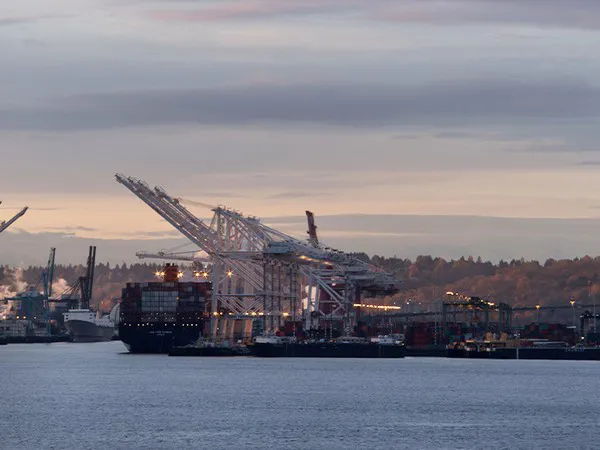Yesterday, part I of this two-part series was published and explored the roots of where the global supply chain started to weaken,
and the challenges began.
Here, in part II Tim Clarke with Vanguard dives a bit deeper into the added challenges that are present with the global movement of perishable items involved.
To help provide some current ‘color’ - At Vanguard International the focus is quickly turning to the upcoming California grape season. USA citrus is wrapping up, and the California stone fruit season is in the latter half. With the perishable nature of fruits and vegetables shipping
schedules must be precisely maintained to manage growers’ risk and customers demand arrival dates – think ETA integrity! Producers are given specific deadlines and always know the window of time that product can be delivered and when containers need to be returned. Those once committed and reliable timelines are becoming more and more less reliable and, in many cases, negatively effecting the quality of product on arrival. “Carriers will actually change the dates (earlier and later) with little to no notice and there is literally nothing we can do about it,” shares Tim Clarke, President of Vanguard International USA. “Our options when this happens looks like scrambling for another vessel, plugging into the container yard, and dealing with the additional charges, or in some cases we have to work with our growers to take fruit back and absorb all the charges associated with that.”
“Carriers will actually change the dates (earlier and later) with little to no notice and there is literally nothing we can do about it,” shares Tim Clarke, President of Vanguard International USA. “Our options when this happens looks like scrambling for another vessel, plugging into the container yard, and dealing with the additional charges, or in some cases we have to work with our growers to take fruit back and absorb all the charges associated with that.”
When we look at the kickoff of the California grape season as usual production starts in Mexico, then moves to the desert of California, and then transitions to the San Joaquin Valley. With the current port challenges, we outlined in detail in part one the desert producers set in stone that they simply would not ship by sea. As a result, for the first shipments this year, Vanguard pivoted to air shipments.
“The volumes for this year’s grape season and quality are all looking very strong, so we are continuing to explore the best transport options to safely get the product to our customers and safeguard our growers’ interests,” says Clarke. “It is safe to say everyone is watching the
situation closely and are on pins and needles, including our sales teams, our inspectors, our growers, and our customers. We are in unchartered waters right now.”

Central to the pivot to air is the uncertainty around vessel schedules and the lack of equipment. However, shipping by air drives up landed prices significantly which is of course going to be passed on along the chain and ultimately to consumers. As you might imagine this has a huge impact on the volumes that can be shipped and sold. As production ramps up we are seeing growers more accepting of sea shipments on direct routes regardless of the challenges -
meaning the container does not need to be transloaded on to a different vessel to reach its final destination.
It isn’t just the exporters and growers that are experiencing challenges. The ripple effect of the current situation is being felt at every link in the supply chain. Clarke shared an example of the
situation that the local trucking industry is experiencing. A common route from the Port of Long Beach to Exeter, California and back is something local truckers can usually do two times per day. The normal wait time to load a container, chassis, and a generator set, to keep refrigeration at the proper temperature, would be on the conservative side, 2 hours. The wait times now are on average 6- 8 hours, meaning only 1 trip per day. This cuts revenue by 50% for an industry that cannot afford to see those margins reduced.
To share just one example – a container of mango and pineapples from Taiwan to Vladivostok, Russia should take 6 days. With all the many challenges a recent shipment took 48 days. All you need to do is take a quick look in YOUR fruit bowl to know how devastating the
impact of this can be.
While customers are still asking, ‘where in the world is my container?’ when you finally do get a container of goods the price is sky high. Overall, we are seeing prices increasing from $4,500 to $12,000 to ship from point A to point B. At the end of the day, that increased cost is going to impact the final price of goods to the consumer, which consumers are already seeing and expecting to surge even higher.
As industry leaders are working around the clock to solve the supply chain challenges everyone is facing, another massive domino is quickly approaching. Not only are back-to-school supplies
attempting to be delivered, but retailers are also seeing delays in shipments and are placing holiday orders early. So back-to-school and the holiday buying season is stacking on top of an already very fragile global system causing only more pressure and rising costs. Even with the bulk of these items being non-perishable, the problem is simply the congestion this will create for all industries.
“I’ve had many conversations with industry leaders and the general consensus is that the pressure we are experiencing on our supply chain will likely not be relieved until the second quarter of 2022,” shared Clarke. “But then again, we know that there can be another unknown domino that changes that prediction just around the corner. I’ve learned to only expect the unexpected right now.”
